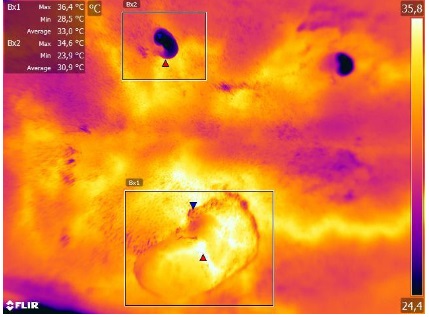Diagnostic applicability of infrared thermography in the evaluation of canine mammary tumors
DOI:
https://doi.org/10.21708/avb.2023.17.1.11243Resumo
Mammary tumors have a high prevalence in bitches and women, and are related to high rates of morbidity and mortality. For the human species, thermography has stood out as a diagnostic tool for breast cancer. However, its clinical benefit in bitches remains unknown. Thus, the goal of the present study was to evaluate the diagnostic applicability of infrared thermography for canine mammary tumors, as well as to correlate tumor temperature with mitotic index and tumor volume. Thermographic and digital images of eight bitches with mammary neoplasms were captured. Thermograms were entered into the FLIR tools software and the temperature of 15 tumor and 15 healthy glands from the contralateral mammary chain was analyzed. There was no significant difference (p = 0.786) between the mean temperature of neoplastic (33.71°C ± 1.86) and healthy (33.54°C ± 1.59) glands. There was a negative and moderate correlation between tumor temperature and mitotic index (ρ = -0.52 p = 0.049). However, no correlation was detected between mammary temperature and tumor volume (p = 0.10). Although thermography allowed no distinction between neoplastic and healthy mammary glands in bitches, it may be promising to assess the proliferative rate of tumors. In addition, malignant neoplasms may be more often hypothermic than healthy tissue.
Downloads

Downloads
Publicado
Edição
Seção
Licença
Copyright (c) 2023 Acta Veterinaria Brasilica

Este trabalho está licenciado sob uma licença Creative Commons Attribution 4.0 International License.
Autores que publicam na Acta Veterinaria Brasilica concordam com os seguintes termos: a) Autores mantém os direitos autorais e concedem à revista o direito de primeira publicação, com o trabalho simultaneamente licenciado sob a Licença Creative Commons Attribution que permite o compartilhamento do trabalho com reconhecimento da autoria e publicação inicial nesta revista. b) Autores têm autorização para assumir contratos adicionais separadamente, para distribuição não-exclusiva da versão do trabalho publicada nesta revista (ex.: publicar em repositório institucional ou como capítulo de livro), com reconhecimento de autoria e publicação inicial nesta revista. c) Autores têm permissão e são estimulados a publicar e distribuir seu trabalho online (ex.: em repositórios institucionais ou na sua página pessoal) a qualquer ponto antes ou durante o processo editorial, já que isso pode gerar alterações produtivas, bem como aumentar o impacto e a citação do trabalho publicado (Veja O Efeito do Acesso Livre).


 Esta obra está licenciada com uma Licença
Esta obra está licenciada com uma Licença 